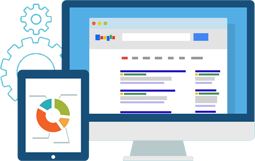
Key Performance Indicators for Your Online Business
As an online business owner, it’s essential to keep track of key performance indicators (KPIs) to evaluate your business’s success and identify areas for improvement. It will help keep the profits coming in and recognize any problem areas before they affect your business too much.

Here are some of the essential KPIs for online businesses:
Website Traffic
Website traffic is a critical KPI for online businesses, as it measures the number of visitors to your site. You can use tools like Google Analytics to track your website traffic, including the number of unique visitors, page views, and bounce rate. An increase in website traffic can indicate increased brand awareness and more potential customers.
Conversion Rate
Conversion rates are the percentages used in digital marketing to evaluate website visitors who completed a desired action, like making a purchase or filling out a form. A high conversion rate is an indication that your website effectively converts visitors into customers. You can improve your conversion rate by optimizing your website design and user experience, creating compelling content, and implementing effective calls to action.
Customer Acquisition Cost
Customer acquisition cost (CAC) measures the amount of money you spend to acquire each new customer. To calculate CAC, divide your total marketing and advertising costs by the number of new customers acquired in a given period. A high CAC indicates that your marketing efforts are not effectively reaching your target audience, and you may need to adjust your strategy.
Customer Lifetime Value
Customer lifetime value (CLV) measures the total amount of revenue a customer will generate throughout their relationship with your business. To calculate CLV, multiply the average purchase value by the average number of purchases per year and multiply that by the average customer lifespan. A high CLV indicates that your business is generating long-term revenue from each customer, making it more profitable in the long run.
Return on Investment
Return on investment (ROI) measures the return on investment for a specific marketing or advertising campaign. To calculate ROI, divide the total revenue generated by the campaign by the total cost of the campaign. A high ROI indicates that your marketing efforts are generating a positive return on investment, and you may want to invest more resources in those efforts.
Social Media Engagement
Social media engagement measures the level of engagement with your brand on social media platforms. This includes likes, shares, comments, and follows. Social media engagement can indicate the effectiveness of your social media marketing strategy, the relevance of your content, and your brand’s overall reputation.
Email Open and Click-Through Rates
Email open and click-through rates measure the effectiveness of your email marketing campaigns. Open rates measure the percentage of recipients who open your email, while click-through rates measure the percentage of recipients who click on a link within your email. A high open and click-through rate indicates that your email marketing campaign effectively reaches your target audience and drives engagement.
Conclusion
In conclusion, tracking essential KPIs is crucial for the success of any online business. By monitoring these metrics, you can identify areas for improvement, optimize your marketing strategies, and make data-driven decisions to grow your business.

